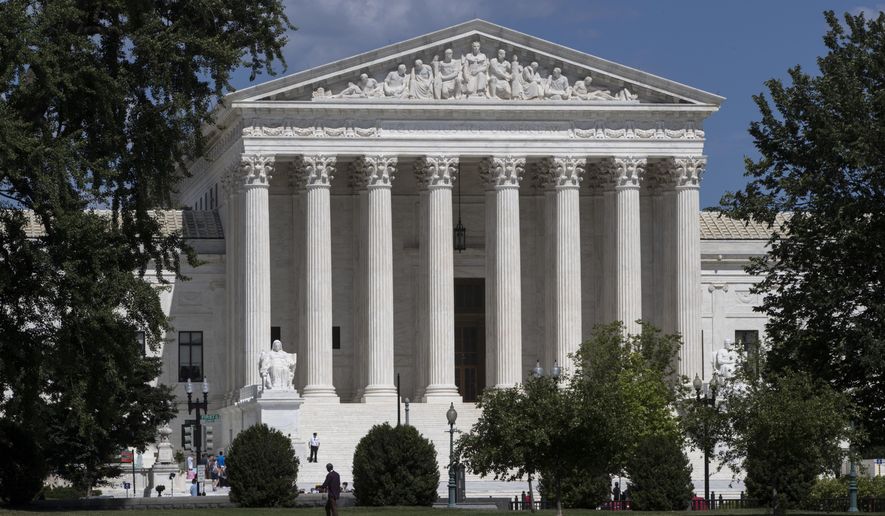WASHINGTON (AP) - In a case that could reshape American politics, the Supreme Court appeared split Tuesday on whether Wisconsin Republicans gave themselves an unfair advantage when they drew political maps to last a decade.
If Justice Anthony Kennedy, whose vote almost certainly controls the outcome, is prepared to join his liberal colleagues, the court could rule for the first time that districting plans that entrench one party’s control of a legislature or congressional delegation can violate the constitutional rights of the other party’s voters. That could lead to changes in political maps across the country.
While both parties seek maximum partisan advantage when they can, Republicans controlled more state governments after the 2010 census and aggressively used redistricting to lock in electoral advantages to last for the next 10 years.
Kennedy suggested, as he did in another redistricting case 13 years ago, that courts perhaps could be involved in placing limits on extremely partisan electoral maps.
But he did not tip his hand about whether the Wisconsin map that favors Republicans crossed a constitutional line.
Throughout the session, the justices and lawyers alike appeared to cast their questions and remarks with the hope of attracting Kennedy. He wrote in 2004 that he would be open to ruling for the challengers if the court could be shown a good way to measure and manage excessively partisan districts.
Paul Smith, the same lawyer who failed to get Kennedy’s vote and thus a majority 13 years ago, said technology and data analysis had so improved since then that there are good ways to measure when one party gives itself an unfair edge in creating districts.
Without the court’s intervention, Smith said on behalf of the Democratic voters, the next round of redistricting after the 2020 census will see far more extreme partisan maps.
“You are the only institution in the United States that can solve this problem just as democracy is about to get worse,” Smith said.
“You paint a very dire picture,” Justice Samuel Alito replied dryly. He seemed unpersuaded.
The conservative justices were skeptical about striking down the state’s map or even involving courts in the inherently political process of redistricting.
Chief Justice John Roberts worried about involving the Supreme Court in a glut of partisan redistricting claims that would follow if the Wisconsin Democrats prevail.
“We’ll have to decide in every case whether the Democrats win or the Republicans win,” Roberts said, a scenario that he said would damage the court’s credibility.
The liberal justices appeared to favor the Democratic voters who challenged the Wisconsin plan. Republicans who controlled the legislature and the governor’s office adopted electoral maps that have given themselves a significant advantage in the state Assembly in a state that is otherwise roughly divided between the parties.
Justice Ruth Bader Ginsburg said that a decision upholding the Republican-drawn districts in Wisconsin would encourage one party’s lawmakers to stack the deck against their opponents when they control the process and reduce the number of legitimately contested elections.
“What becomes of the precious right to vote?” she asked.
Representing Wisconsin, Misha Tseytlin urged the court not to succumb to the other side’s “scare tactics about what will happen next.”
People waited in line for hours for a chance to view the argument on the second day of the court’s term. Roberts turned down a request for live audio of the argument.
The packed house included former California Gov. Arnold Schwarzenegger, among a handful of prominent Republicans who want the court to rein in partisan redistricting.
The Supreme Court has never thrown out a political map because it is too partisan. Courts have struck down districts as racially biased for decades, and other partisan districting lawsuits are moving through the courts in Maryland and North Carolina.
In Wisconsin, a lower court sifted through evidence showing that Republicans packed Democrats into some districts and spread them out across others to maximize gains for the GOP. In one analysis, Democrats captured far fewer state Assembly seats even when they won roughly the same percentage of the statewide vote as Republicans.
The lower court concluded that the districting plans were drawn to discriminate against Democrats, the Republicans’ advantage would endure even in the face of a strong Democratic showing at the polls and the plans could not be explained by other, non-partisan reasons.
The state is arguing the justices should put an end to courts’ consideration of partisanship in districting plans and cautioning that far from being manageable, a ruling for the Democratic voters would open the door to a flood of lawsuits that would be based on cherry-picked evidence and hard for judges to manage.
Justice Neil Gorsuch, the newest member of the court, likened the court’s task in finding a way to measure partisanship with his preparations for grilling steak. “I like my turmeric and other spices, but I’m not going to tell you how much. What’s this court supposed to do, a pinch of this, a pinch of that?” Gorsuch asked.
A decision in Gill v. Whitford, 16-1161, is expected by spring.
___
This story has been corrected to show the case number is 16-1161.




Please read our comment policy before commenting.